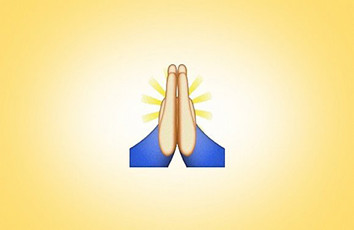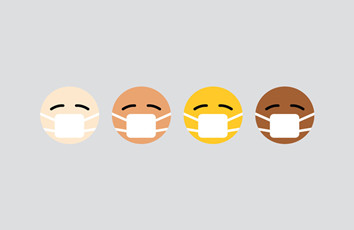疫情期间“双手合十”表情符号使用量大增
疫情改变着人们的生活,改变着人们的交流方式,也改变着人们使用的表情符号。追踪调查发现,双手合十、戴口罩、细菌和肥皂的表情符号近来使用量大大增加。
At a time when in-person conversations are harder to come by, many people are choosing to express their thoughts about the pandemic with emojis. But perhaps no emoji has come to embody the hopes and fears of this unthinkable moment as much as the folded hands emoji.
在难以进行面对面谈话的时期,许多人选择用表情符号来表达自己对大流行病的想法。但也许没有哪个表情符号能像双手合十的表情符号一样体现这个难以想象时刻的希望和恐惧。
The folded hands emoji has popped up in more tweets than ever before to help express our feelings about seemingly every aspect of a health crisis that can sometimes defy words. It’s used to give thanks to frontline workers, send prayers to loved ones and express gratitude for finding toilet paper on supermarket shelves.
双手合十的表情符号从未如此频繁地出现在推特中,用于表达我们对一场难以言说的健康危机方方面面的感受。这个表情符号被用来感谢一线的工作人员,给所爱的人送去祈祷,为在超市货架上找到卫生纸而表达感激。
The emoji, sometimes called prayer hands, was used 25% more often in April than in August, the last time that particular character was analyzed by Emojipedia, which tracks trends and frequency of emoji use on Twitter. That spike made it the eighth most popular emoji for the month - and cemented its position as a visual emblem for how we feel during the pandemic.
这个表情符号有时候也被称为“祈祷手”,在今年四月份的使用频率比Emojipedia网站去年八月份分析这个表情符号时上升了25%。该网站追踪表情符号在推特上被使用的潮流和频率。“祈祷手”使用量的激增使其在四月份最受欢迎的表情符号中排行第八,并加固了其作为表达人们在疫情期间感受的视觉符号地位。

As coronavirus cases ticked up and lockdowns spread around the world, the way we communicate evolved quickly. Water-cooler conversations were replaced by Slack chats. Happy hours and birthday parties now unfold on Zoom. Phone calls made a comeback. And people are increasingly relying on emoji to express their thoughts and gestures to an audience they can no longer see in person.
随着新冠肺炎病例的增加和世界各地陆续进入封锁状态,人们交流的方式迅速地发生演变。饮水机旁的聊天被职场聊天软件Slack上的交谈取代。欢乐时光和生日派对现在转移到视频会议软件Zoom上开展。打电话的交流方式也复兴了。此外,人们越来越多地借助表情符号向无法见面的人表达自己的想法和姿态。
Nearly one in five tweets now include an emoji, up from about one in six tweets during same time last year, according to Emojipedia. Icons such as the face with a medical mask, the microbe and a bar of soap have also spiked in messages specifically associated with the coronavirus.
Emojipedia网站称,如今有近五分之一的推文包含一个表情符号,相比去年同期的六分之一有所增加。在和新冠肺炎明确相关的信息中,戴医用口罩的脸、细菌和肥皂的表情符号也大大增加

Yet, some things haven’t changed. Emojipedia found the most popular emoji remains the tears of joy face, which was named as word of the year in 2015 by the Oxford Dictionary.
然而,有些东西没有变。Emojipedia网站发现,最受欢迎的表情符号依然是笑中带泪的脸,该符号曾被牛津辞典评为2015年的年度词汇。

In the absence of more new coronavirus emoji, some have gotten creative with how they’ve been sharing existing emoji during the pandemic. In Spain, for example, the pairing of the microbe emoji with the crown emoji - “crown” translates to “la corona” in the Spanish language - has gained traction.
在没有增加新冠疫情表情符号的情况下,有些人开始在疫情期间创造性地使用现有的表情符号。举例来说,在西班牙,人们将细菌表情符号和王冠表情符号组合在一起来表示新冠病毒(crown翻译成西班牙语是la corona),这一用法越来越受欢迎。
Others are turning to options like the folded hands emoji, which first appeared on smartphones in the US in 2012. Long before the pandemic, it had been used to represent many things, from a high five and a Namaste icon to a token of gratitude or prayer.
其他一些人则开始使用双手合十的表情符号,该符号于2012年在美国的智能手机上首次出现。早在这次大流行病前,双手合十的表情符号就被用来代表许多意思,比如,举手击掌、印度合十礼,以及感恩或祈祷。
Angela Guzman, one of the early emoji designers for iOS, said the best approach to emoji design is to create visual symbols with versatility to evolve with people and the times they live in.
苹果操作系统表情符号最早的设计者之一安杰拉·古兹曼说,设计表情符号的最佳思路是创造出可以随着人们和时代一起进化的通用性视觉符号。
“A word that we used five years ago may mean something else today - the same is true of emojis,” said Guzman. “For this reason, when designing an emoji, current trends can play a role in its creation. But it’s important not to add too many embellishments that will not last with the test of time.”
古兹曼说:“我们五年前用的一个词今天也许是另一个意思——表情符号也是如此。因此在设计表情符号时,当前的潮流可以影响创作,但重要的是不要加进太多不能经受时间考验的修饰成分。”


